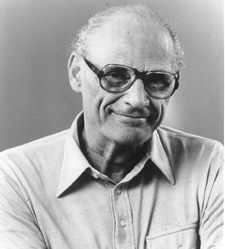On This Day in History, February 10: Death of a Playwright

Arthur-miller_2.jpg
The great American playwright Arthur Miller died at his home in Roxbury, CT on Feb. 10, 2005, at the age of 89. Best known for his landmark dramatic play “Death of a Salesman” and his unlikely marriage to Marilyn Monroe, Miller was raised in Brooklyn and spent many of his adult years in the borough as well.
Born in Manhattan on Oct. 17, 1915, Miller was the son of a coat manufacturer. His parents were forced to move to Brooklyn in 1928 as the result of Depression-era business losses. During those lean years, the Miller family lived in the Midwood section of the borough.
Miller’s residence in Brooklyn was a small house at 1350 East 3rd, a dead-end street.